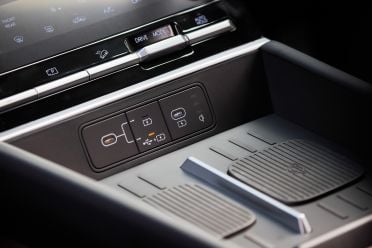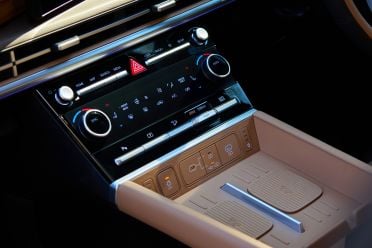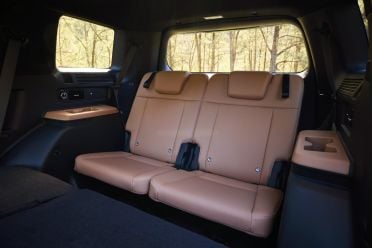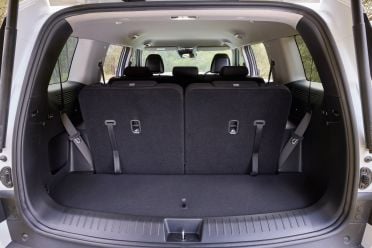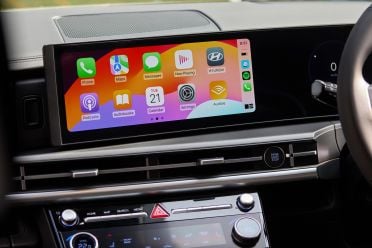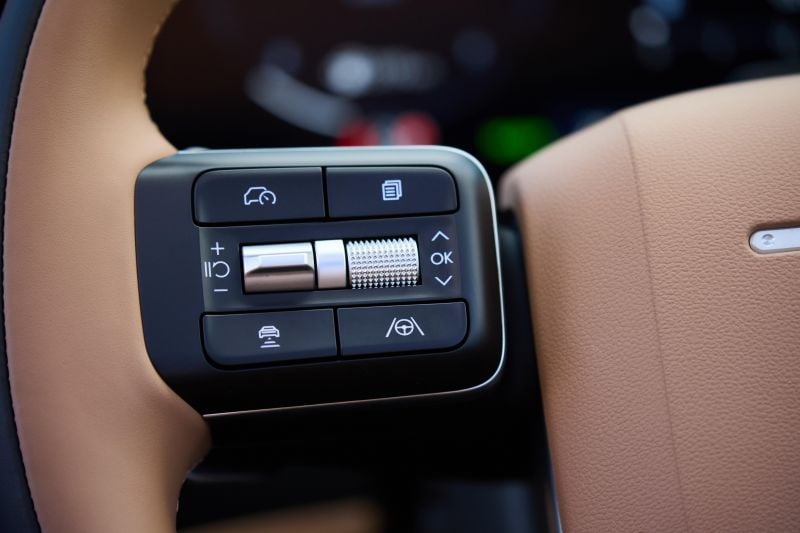Talk about a dramatic change between generations.
The all-new, fifth-generation take on the Hyundai Santa Fe is a spectacular shift for the brand and the nameplate itself – it’s bigger, better equipped, and clearly a lot bolder than it’s ever been.
In fact, the design is arguably the biggest talking point about this boxy new model, with the rear end in particular proving a talking point at launch. Some people mightn’t be fans, and could rule this car out based on that.
But that, in my opinion, would be a colossal mistake. Because the 2024 Hyundai Santa Fe is a mostly spectacular thing – read on to find out what makes it so good, and the things that might make it less appealing depending on your preferences.

How much does the Hyundai Santa Fe cost?
At a glance, the prices seem a fair bit higher than the previous model, but there are cheaper turbo-petrol versions due at the end of 2024 which will bring the asking price down a bit.
| Model Variant | Price |
|---|---|
| 2024 Hyundai Santa Fe Hybrid FWD | $55,500 |
| 2024 Hyundai Santa Fe Hybrid AWD | $58,500 |
| 2024 Hyundai Santa Fe Hybrid Elite AWD | $65,000 |
| 2024 Hyundai Santa Fe Hybrid Calligraphy 7 Seat AWD | $75,000 |
| 2024 Hyundai Santa Fe Hybrid Calligraphy 6 Seat AWD | $75,500 |
Prices exclude on-road costs
If you compare the hybrids against the previous-gen model where the petrol-electric option was offered, the prices are up a bit – but the standard equipment levels are also up significantly more than that sum suggests.
All the spec details are listed in the section further down.
To see how the Hyundai Santa Fe compares against the competition, check out our comparison tool.
What is the Hyundai Santa Fe like on the inside?
It’s more than a step-change in terms of the interior design, too, with a massive rethink of what the cabin of the Santa Fe should look and feel like – and it looks and feels pretty bloody good.
The twin-screen 12.3-inch display array really looks amazing, and kudos to Hyundai for fitting the proper displays in all grades, rather than opting for the less-impressive part-digital design employed in other cars in the Hyundai-Kia world.
It is an impressive setup, and cuts its own shape in the broad and nicely finished dashboard, which has a selection of trim finishes depending on the grade.
The base model has a tidy black-on-silver look, while the Elite changes things up with a more posh trim across the doors and dash, and the Calligraphy takes it to the next level – and even comes with a few colour options for the interior.
There’s a H motif to lots of the interior elements, and the Elite and Calligraphy models get an ambient light strip that takes that shape across the width of the dashboard, too.
It is a truly tidy look and, depending on the grade, you’re getting some really spectacular trim choices inside.
For me, the tartan cloth in the base model is appealing for its softness, while the dad in me thinks the Elite would be better with its wipeable leather trim, though the seats feel a lot less yielding in that spec. The Calligraphy? If you can justify it, then do it!
The touch panel to control the air-conditioning and ventilation is nice to look at. It’s not as tactile as ‘old-school’ buttons and dials, but thankfully you do learn your way around the controls pretty quickly. Beware – if you leave the driver distraction monitor on, it will beep at you if you look down at those controls… and that’s very irritating!
There is ample storage up front, with the shift-by-wire gear selector having been rehomed to the steering column to make a huge cavity of space between the front seats. Plus there’s a dual glovebox layout, with the top-spec including a UV-C cleaning system.
There is a storage tray at floor height which is large enough for a handbag or takeaway food bags.
Above it is another tray area with a section for your phone – including a single wireless charging pad in the base spec, and two wireless pads in the Elite and Calligraphy. There are cupholders there, and a covered centre console bin with some handy storage tricks to it, too.
Second-row accommodation is great, with a 60:40 sliding second row seat with reclining option for both sides, and easily enough space for someone my size (182cm/6’0”) to fit with room to spare in front and behind.
There are plenty of great storage options in the second row, with each door housing a trio of holsters for bottles or cups, and there are map pockets on the seat backs, a sliding drawer that comes out from behind the centre console, and a flip-down armrest with cupholders.
Other amenities include a pair of USB-C ports in the backs of the front seats, and while there are no knee-height air vents, there are B-pillar face-level vents that should do the job for those in the window seats, while a middle-seater might need to ask for air from the front cabin.
There are three top-tether points and two ISOFIX positions in the second row, and it’s a wide enough cabin that three-seats-across seems like it will be doable.
Third-row access is decent, but the fact the easiest access point is from the roadside (behind the driver’s seat, rather than the kerbside) means that you might need to make sure your backseat bandits are on their best behaviour to get into the back seats.
Once in the back, the space is surprisingly good. I could sit in the third row with someone my size ahead of me, and we were both comfortable.
There’s good head room, knee room is acceptable (in a bit of a knees-up position, but that’s to be expected), and there’s even decent foot room, but anyone with bare feet in the back might just want to be careful when the second-row is being slid back.
Great to see there are ISOFIX points and top-tethers for the very back seats, too, and all variants come with a fan controller and vents in the back, as well as cupholders in the wheelarch covers, and there’s a decent view out from the third row, too.
Obviously if you use all three rows of seats your boot space will be pretty limited – but I managed to fit in a couple of backpacks on test.
With the third-row folded down there’s 628 litres of cargo space on offer, which – if you drop the second-row seats using the standard electric controllers in the boot – increases to a handy and sleepable (according to Hyundai’s camping-conscious Korean team) 1949 litres.
And don’t go thinking that you miss out on a spare wheel, either. The packaging of this SUV is so clever, the brand has even managed to fit a full-size spare under the boot floor – impressive!
One thing that might improve this already impressive design is the addition of an opening glass section for the boot. It has a massive tailgate, and if you reverse into a spot only to find you can’t open the boot, it would just be a really handy way to access the boot area without having to open the entire rear door.
| Dimensions | Hyundai Santa Fe Hybrid |
|---|---|
| Length | 4830mm |
| Width | 1900mm |
| Height | 1720mm |
| Wheelbase | 2815mm |
| Boot space | 628L – 3rd row folded 1949L – 2nd row folded |
To see how the Hyundai Santa Fe compares against the competition, check out our comparison tool.
What’s under the bonnet?
At launch all Santa Fe models will be powered by a 1.6-litre turbocharged hybrid system.
| Tech Specs | Hyundai Santa Fe Hybrid |
|---|---|
| Engine | 1.6L 4cyl turbo HEV |
| Power | 132kW – 1.6 T-GDI 44.2kW – e-motor Total – 172kW @ 5600rpm |
| Engine torque | 265Nm – 1.6 T-GDI 264Nm – e-motor Total – 367Nm @ 1000-4100rpm |
| Transmission | 6-speed auto |
| Driven wheels | FWD or AWD |
| Kerb weight | 1951kg – FWD 2014kg – AWD |
| Fuel economy – claimed | 5.6L /100km |
| Fuel economy – as tested | 6.9L /100km |
| CO2 emissions – claimed | 128g /km |
| Fuel tank size | 67 litres |
| Fuel requirement | 91 RON |
| CO2 emissions | 122g/km – FWD 129g/km – AWD |
| Maximum tow capacity | 750kg – unbraked 1650kg – braked 100kg – towball download |
To see how the Hyundai Santa Fe compares against the competition, check out our comparison tool.
How does the Hyundai Santa Fe drive?
The powertrain is the big talking point here.
The good stuff? It’ll use EV mode a lot, both at urban speeds and on the open road, and the transition between electric and hybrid modes is pretty smooth.
It’s also kinda cool how it feels like the transmission is shifting in electric mode – because it is – and you get more of a tactile experience with the car as a result of that.
There’s enough grunt to get things moving without fuss, and there are different drive modes to play with – Sport, Eco, and My Mode with a couple of configurable elements – and in the most dynamic setting you get a bit more out of the powertrain, though the transmission can be a tad eager to hang on to gears.
In AWD models there’s also a Terrain control button, with Snow, Mud and Sand on offer, though you will need to be mindful of the overhangs of this car if you plan to get much further than a campsite track, and also the ground clearance – 177mm – means it’s hardly going to tackle a powerline track.
It has regenerative braking, so as to attempt to feed a bit of energy back to the battery in urban settings, and while that’s admirable the brake pedal feel can take a bit of getting used to, as it is somewhat airy at the top of travel.
There’s no Aussie-specific ride and handling tune for the Santa Fe, but it has been tested and signed off to be the “best fit” for our market, according to the brand.
The suspension is mostly well sorted, a bit firm feeling at times and it can clunk a bit over sharp joins in the road at pace, but around town or in country road touring, it seems to handle the lumps in the road decently, if not exceptionally.
There’s adequate responsiveness and accuracy to the steering to make this circa-two-tonne SUV feel pretty manageable at lower speeds, and while the visibility for the driver is really quite good, the fact you’ve got some great safety aids and cameras to help with low-speed moves means you get a great idea of what you’re doing when parking.
Now, on the topic of those safety systems, it has to be said that they are simply the most defining consideration for the drive experience – let me explain why…
There’s a driver attention warning system with a camera that watches your eyes, and it is ridiculously oversensitive to you adjusting things on the screen or even looking for a safe gap in traffic.
Likewise, the speed sign recognition system, which will display an image of what it thinks the speed limit is – there are no 85km/h limits in NSW, but that’s what it showed me, for some reason – and it will also beep at you if you’re doing 1km/h more than the limit it thinks is correct, and continue to beep at you until you comply.
It’s infuriating…
What’s more annoying is that it defaults back on as soon as you turn off the ignition, so if you don’t like it (and I’m guessing you won’t), then you have to go through a sequence of button and screen presses to turn it back off. Every time you drive it, seconds of your life wasted…
Anyway, it’s annoying, but Hyundai’s product team assures me there is some kind of fix coming for it. Frankly, there should be, because otherwise this is an entirely liveable and likeable drive experience.
What do you get?
All versions come pretty handsomely equipped.
Santa Fe standard equipment:
- 20-inch alloy wheels
- LED headlights
- Auto high-beam
- Proximity entry with push-button start
- Electronic parking brake with auto hold function
- 3 x drive modes – Eco, Sport, My Drive
- 3 x multi-terrain drive modes – AWD only
- Dual-zone climate control
- 10-way power-adjustable driver’s seat
- Obsidian Black cloth upholstery
- Leather-wrapped steering wheel
- 12.3-inch digital instrument cluster
- 12.3-inch infotainment touchscreen
- Over the air (OTA) software updates
- Apple CarPlay, Android Auto – wireless, wired
- Wireless smartphone charger
- Surround-view camera system
- 6-speaker sound system
- Heated front seats
- Power tailgate
- Rear privacy glass
- Full-size alloy spare wheel
Santa Fe Elite adds:
- Silver exterior highlights
- Remote Smart Parking Assist
- Black leather seats
- Suede headlining
- 10-way power-adjustable passenger seat
- Heated steering wheel
- Bose premium audio system – 12 speakers
- Dual wireless smartphone charger
- Bluelink connected services
- Auto-dimming rearview mirror
Santa Fe Calligraphy adds:
- Unique 20-inch wheels
- Glass sunroof
- Head-up display
- Digital camera rearview mirror
- Black Ink Nappa leather upholstery
- Relaxation function – front seats
- Memory function – front seats, mirrors
- Heated outboard second-row seats
- Ventilated front seats
- UV-C sanitisation tray
- UV and infrared insulated windscreen, front windows
The Calligraphy is also offered with a six-seat layout with second-row electrically adjustable captain’s chairs, which might offer a more plush experience but may limit practicality somewhat.
Is the Hyundai Santa Fe safe?
The Hyundai Santa Fe has yet to be tested by ANCAP or Euro NCAP.
Standard safety features across the range include:
- Autonomous emergency braking (AEB)
- Pedestrian, Cyclist detection
- Junction assist
- Adaptive cruise control with stop and go
- Blind-spot assist
- Blind Spot View Monitor
- Driver attention warning
- Forward attention warning
- Leading vehicle departure alert
- Evasive steering assist function
- Intelligent speed limit assist
- Lane Following Assist
- Lane keep assist
- Parking Collision Avoidance Assist
- Rear cross-traffic assist
- Rear occupant alert
- Safe exit assist
- Front, rear parking sensors
- Surround-view monitor – 360 camera
In a win for families who plan to use this car with seven seats regularly, the Santa Fe now has full airbag coverage for the third-row occupants.
In fact, it has 10 airbags fitted: dual front, driver’s knee, front centre, front side, second-row side and full-length curtain airbags.
How much does the Hyundai Santa Fe cost to run?
As with all Hyundai models, there’s a five-year/unlimited-kilometre warranty, and Santa Fe Hybrid models also get an eight-year/160,000km warranty for high-voltage components like the e-motor and lithium battery.
Servicing is every 12 months/10,000km, which is a bit more needy than some rivals. There is also a roadside assistance program that renews every time you service your car with Hyundai.
| Service | Price |
|---|---|
| 12 months / 10,000km | $459 |
| 24 months / 20,000km | $459 |
| 36 months / 30,000km | $569 |
| 48 months / 40,000km | $459 |
| 60 months / 50,000km | $459 |
| Total | $2405 |
CarExpert’s Take on the Hyundai Santa Fe
Mums and dads out there – this could be your next family SUV.
If you can live with the annoying safety features, or just ignore them, then you’ll be getting into one of the most enticing vehicles yet from the H brand.
That also comes with great real-world efficiency, amazing space, great design details and whole heap of street presence. Or, you might want to wait for our review of the cheaper turbo-petrol model, due later this year…
Click the images for the full gallery
MORE: Buy a Hyundai Santa Fe
MORE: Everything Hyundai Santa Fe
















